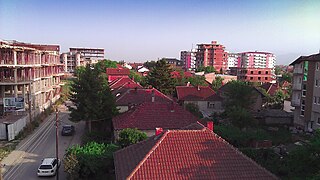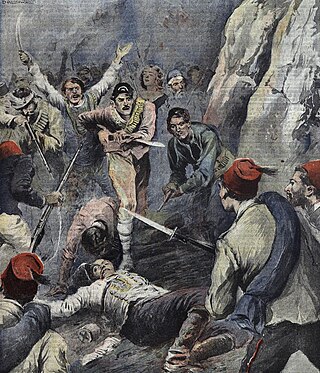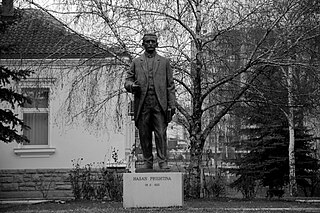
Mitrovica, also referred to as South Mitrovica, is a city in northern Kosovo and administrative center of the District of Mitrovica. In 2013, the city was split into two municipalities, South Mitrovica and North Mitrovica. Settled 10 km (6.2 mi) from Ujmani/Gazivoda Lake, on the confluence of the rivers Ibër, Sitnicë, Lushta, and Trepça, the city is surrounded by the mountains of Kopaonik, Rogozna, Mokna, and Çyçavica. According to the 2011 Census, the two municipalities had 97,686 inhabitants of which 85,360 reside in south and 12,326 in north.

Prokuplje is a city and the administrative center of the Toplica District in southern Serbia. As of 2022 census, the municipality has a population of 38,054 inhabitants.
The history of Kosovo dates back to pre-historic times when the Starčevo culture, Vinča culture, Bubanj-Hum culture, and Baden culture were active in the region. Since then, many archaeological sites have been discovered due to the abundance of natural resources which gave way to the development of life.

Lipjan or Lipljan is a town and municipality located in the Pristina District of Kosovo. According to the 2011 census, the town of Lipjan has 6,870 inhabitants, while the municipality has 57,605 inhabitants.

The District of Ferizaj is one of the seven districts of Kosovo. Ferizaj is the seat of the district. According to the 2024 census, the total population of the district is 180,897.
Obiliq is a town and municipality in Kosovo. According to the Kosovo Agency of Statistics (KAS) estimate from the 2011 census, there were 21,549 people residing in Obiliq Municipality, with Kosovo Albanians constituting the majority of the population.

Skenderaj or Srbica is a town and municipality located in the Mitrovica District of Kosovo. According to the 2021 census, the municipality of Skënderaj has 52,586 inhabitants.

Pristina or Prishtina is the capital and largest city of Kosovo. It is the administrative center of the eponymous municipality and district.

The massacres of Albanians in the Balkan Wars were perpetrated on several occasions by the Serbian and Montenegrin armies and paramilitaries during the conflicts that occurred in the region between 1912 and 1913. During the 1912–13 First Balkan War, Serbia and Montenegro committed a number of war crimes against the Albanian population after expelling Ottoman Empire forces from present-day Albania, Kosovo, and North Macedonia, which were reported by the European, American and Serbian opposition press. Most of the crimes occurred between October 1912 and the summer of 1913. The goal of the forced expulsions and massacres was statistical manipulation before the London Ambassadors Conference to determine the new Balkan borders. According to contemporary accounts, around 20,000 to 25,000 Albanians were killed in the Kosovo Vilayet during the first two to four months, before the violence climaxed. The total number of Albanians that were killed in Kosovo and Macedonia or in all Serbian occupied regions during the Balkan Wars is estimated to be at least 120,000. Most of the victims were children, women and the elderly. In addition to the massacres, some civilians had their lips and noses severed. Multiple historians, scholars, and contemporary accounts refer to or characterize the massacres as a genocide of Albanians or the Muslim population in the Balkans as a whole. Further massacres against Albanians occurred during the First World War and continued during the interwar period.

The Albanian revolt of 1910 was a reaction to the new centralization policies of the Young Turk Ottoman government in Albania. It was the first of a series of major uprisings. Rebels were supported by the Kingdom of Serbia. New taxes levied in the early months of 1910 led to Isa Boletini's activity to convince Albanian leaders who had already been involved in a 1909 uprising to try another revolt against the Ottoman Empire. The Albanian attacks on the Ottomans in Priştine and Ferizovik, the killing of the Ottoman commander in İpek, and the insurgents' blocking of the railway to Skopje at the Kaçanik Pass led to the Ottoman government's declaration of martial law in the area.

Historical monuments in Pristina are made up of 21 monuments out of a total of 426 protected monuments all over Kosovo. A large number of these monuments date back to the Byzantine and Ottoman periods. Since 1945, the Yugoslav authorities followed the idea of constructing a modern Pristina by relying in the urban development motto “destroy the old, build the new” and this resulted with major changes in the structure of the buildings, their function and their surrounding environment. However, numerous types of monuments have been preserved, including four mosques, a restored orthodox church, an Ottoman bath, a public fountain, a clock tower, several traditional houses as well as European-influenced architecture buildings such as the Museum of Kosovo. These symbolize the historical and cultural character of Pristina as it was developed throughout centuries in the spirit of conquering empires.

Education in Pristina, the capital of Kosovo, consists of primary, secondary and higher education. Pristina houses a number of public and private institutions, such as the University "Hasan Prishtina", the National Library of Kosovo, and the Academy of Sciences and Arts of Kosovo. Throughout the last century Pristina has attracted a considerable number of students from Kosovo. Today, the city of Pristina hosts a large number of intellectuals, professors, academics, students, and professionals in various spheres.
Kosovo has a rich heritage in archaeology, however the field suffers from a lack of substantial institutional research. Since prehistory, the advantageous geostrategic position and abundant natural resources of the area have been suitable for the emergence of life. This is shown by the traces of hundreds of archaeological sites discovered throughout the country, displaying the abundant archaeological legacy.
Ferizaj, the fifth largest city in Kosovo, has been populated since the pre-historic era.
Talinoc i Muhaxhirëve, also known as Talinovce or Muhadžer Talinovac, is a village in Ferizaj Municipality, Kosovo. According to the Kosovo Agency of Statistics (KAS) estimate from the 2011 census, there were 1,961 people residing in Gaçkë, with Albanians constituting the majority of the population.

Albania's Golgotha: Indictment of the Exterminators of the Albanian People, is a German published document of 1913 which was written by the Austrian publicist and politician Leo Freundlich (1875-1953). The document is a compilation of news which he gathered when traveling in the Vilayet of Kosovo during the Serbian invasion of 1912-1913, explaining in detail the full-scale massacres, rape, expulsions, torture and abuse which Albanian civilians suffered under rule by the Serb army and Chetnik paramilitaries. According to the documents of Freundlich, 25,000 Albanians were massacred in the Kosovo Vilayet halfway through the First Balkan War. The document describes the methods of ethnic cleansing which was used to remove the Albanian population of North Macedonia, Northern Albania, and Kosovo. The document was re-translated by Robert Elsie. The reports were confirmed by the International Commission to Inquire into the Causes and Conduct of the Balkan War.
Nekodim is a village in Ferizaj Municipality, Kosovo. According to the Kosovo Agency of Statistics (KAS) estimate from the 2011 census, there were 3,718 people residing in Nekodim, with Albanians constituting the majority of the population.
Kosovo during World War I was initially, for about a year, completely filled with Serbian military forces, which retreated towards Albania to continue further to Corfu. After the occupation of the territories by Austria-Hungary, the German Empire, and the Kingdom of Bulgaria as allies in the First World War, the occupied territories were divided. The years 1915–1918 in the occupied Bulgarian zone are considered the most tragic years of poverty and hunger for the population of this part of Kosovo. The lack of bread was felt not only because of the drought, but also because the invaders confiscated the people's grain. Unlike the Bulgarian occupation zone, the Austro-Hungarians pursued a policy aimed at benefiting the general populace. They began to disregard some national rights, which for Albanians had vital value.
The Battle of Jezerc was a battle fought between the Kosovo Liberation Army (KLA) and the Yugoslav army on 28 September 1998 in the Operational Zone of Neredime near Kaçanik in the village of Jezerc, during the Kosovo War.


























